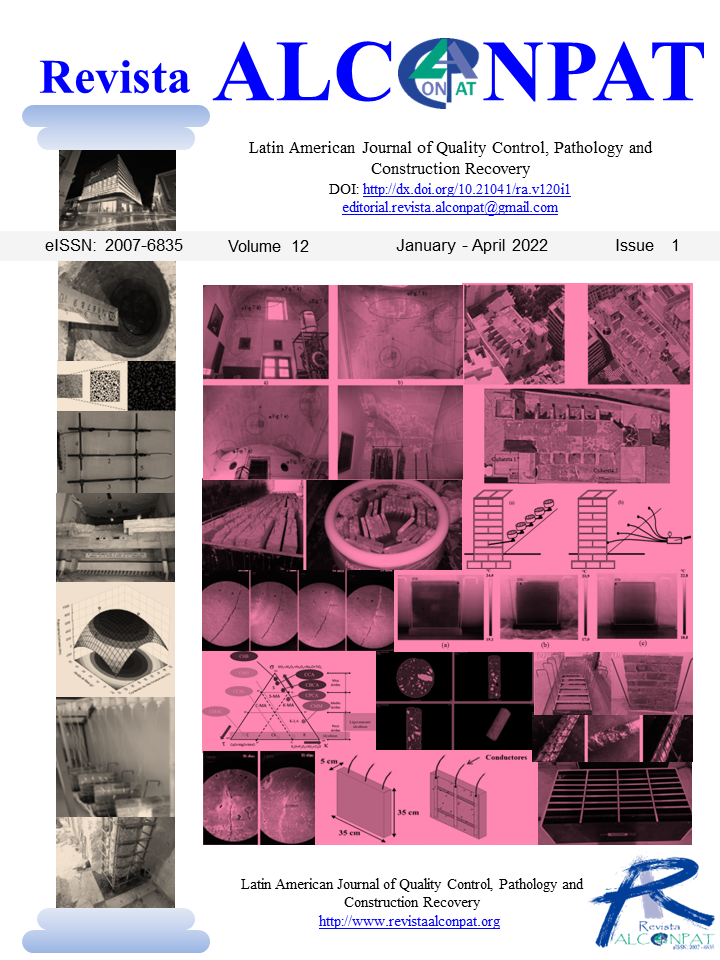Influence of the void ratio of cellular concrete on the corrosion of steel reinforcement
DOI:
https://doi.org/10.21041/ra.v12i1.507Keywords:
void ratio, lightweight concrete, reinforcement corrosionAbstract
The objective of this study was to understand whether voids intensify the triggering of reinforcement corrosion in cellular concrete, for slabs with light specific masses. The methodology was based on four tests: visual inspection, corrosion potential, electrical resistivity, and mass loss. In relation to the L1 family, the L2 and L3 families (higher air content) were shown to be more susceptible to reinforcement corrosion and mass loss from the steel bars in 90% of cases. However, the behavior of some slabs indicates the possibility of the process being asymptomatic with regard to staining, considering that the influence of the cover on the corrosion of the steel bars was verified.
Downloads
References
ABNT – Associação Brasileira de Normas Técnicas. (2003), NBR NM 248: Agregados – Determinação da composição granulométrica. Rio de Janeiro.
ABNT – Associação Brasileira de Normas Técnicas. (2007), NBR 7480: Aço destinado a armaduras para estruturas de concreto armado – Especificação. Rio de Janeiro.
ABNT – Associação Brasileira de Normas Técnicas. (2008), NBR 9833: Concreto fresco - Determinação da massa específica, do rendimento e do teor de ar pelo método gravimétrico. Rio de Janeiro.
ABNT – Associação Brasileira de Normas Técnicas. (2014), NBR 12644: Concreto celular estrutural – Determinação da densidade do concreto no estado fresco. Rio de Janeiro.
Al-Shwaiter, A., Awang, H., Khalaf, M. A. (2021), The influence of superplasticiser on mechanical, transport and microstructure properties of foam concrete. Journal of King Saud University – Engineering Sciences. 1(1):1-9. http://dx.doi.org/10.1016/j.jksues.2021.02.010
Alnahhal, A. M., Alengaram, U. J., Yusoff, S., Singh, R., Radwan, M. K. H., Deboucha, W. (2021), Synthesis of sustainable lightweight foamed concrete using palm oil fuel ash as a cement replacement material. Journal of Building Engineering. 35(1):1-12. http://dx.doi.org/10.1016/j.jobe.2020.102047
ASTM G1-03, Standard Test Method for Corrosion Potentials of Uncoated Reinforcing Steel in Concrete, ASTM International, West Conshohocken, PA, 2017.
ASTM C876-15, Standard Test Method for Corrosion Potentials of Uncoated Reinforcing Steel in Concrete, ASTM International, West Conshohocken, PA, 2015.
Badar, S., Patil, K. K., Bernal, S. A., Provis, J.L., Allouche, E. N. (2014), Corrosion of steel bars induced by accelerated carbonation in low and high calcium fly ash geopolymer concretes. Construction and Building Materials, 62(1):79-89. http://dx.doi.org/10.1016/j.conbuildmat.20114.03.015
Chung, S-Y., Elrahman, M. A., Kim, J-S., Han, T-S., Stephan, D., Sikora, P. (2019), Comparison of lightweight aggregate and foamed concrete with the same density level using image-based characterizations. Construction and Building Materials. 211(1):988-999. http://dx.doi.org/10.1016/j.conbuildmat.2019.03.270
Dong, Y., Su, C., Qiao, P., Sun, L. (2020), Microstructural crack segmentation of three-dimensional concrete images based on deep convolutional neural networks. Construction and Building Materials. 253(1):1-12. http://dx.doi.org/10.1016/j.conbuildmat.2020.119185
Dong, W., Huang, Y., Lehane, B., Ma, G. (2020), XGBoost algorithm-based prediction of concrete electrical resistivity for structural health monitoring. Automation in Construction. 114(1):1-11. http://dx.doi.org/10.1016/j.autcon.2020.103155
Du, F., Jin, Z., She, W., Xiong, C., Feng, G., Fan, J. (2020), Chloride ions migration and induced reinforcement corrosion in concrete with cracks: a comparative study of current acceleration and natural marine exposure. Construction and Building Materials. 263(1):1-11. http://dx.doi.org/10.1016/j.conbuildmat.2020.120099
Green, W. K. (2020), Steel reinforcement corrosion in concrete – an overview of some fundamentals. Corrosion Engineering, Science and Technology. 55(4):289-302. http://dx.doi.org/10.1080/1478422x.2020.1746039
Han, W., Lee, J. S., Byun, Y. H (2021), Volume, strength, and stiffness characteristics of expandable foam grout. Construction and Building Materials. 274(1):1-16. http://dx.doi.org/10.1016/j.conbuildmat.2020.122013
He, T., XU, R.., Chen, C., Yang, L., Yang, R., Yongqi, D. (2018), Carbonation modeling analysis on carbonation behavior of sand autoclaved aerated concrete. Construction and Building Materials. 189(1):102-108. http://dx.doi.org/10.1016/j.conbuildmat.2018.08.199
He, X., Zheng, z., Yang, J., Su, Y., Wang, T., Strnadel, B. (2019), Feasibility of incorporating autoclaved aerated concrete waste for cement replacement in sustainable building materials. Journal of Cleaner Production. 19(2):2-49. https://doi.org/10.1016/j.jclepro.2019.119455
Hou, L., Li, J., Lu, Z., Niu, Y. (2021), Influence of foaming agent on cement and foam concrete. Construction and Building Materials. 280(1):1-13. http://dx.doi.org/10.1016/j.conbuildmat.2021.122399
Kanellopoulos, A., Savva, P., Petrou, M. F., Ioannou, I., Pantazopoulou, S. (2020), Assessing the quality of concrete – reinforcement interface in Self Compacting Concrete. Construction and Building Materials. 240(1):1-12. http://dx.doi.org/10.1016/j.conbuildmat.2019.117933
Khodabakhshian, A., Brito, J., Ghalehnovi, M., Shamsabadi, E. A. (2018), Mechanical, environmental and economic performance of structural concrete containing silica fume and marble industry waste powder. Construction and Building Materials. 169(1):237-251. http://dx.doi.org/10.1016/j.conbuildmat.2018.02.192
Kashani, A., Ngo, T. D., Mendis, P., Black, K. R., Hajimohammadi, A. (2017), A sustainable application of recycled tyre crumbs as insulator in lightweight cellular concrete. Journal of Cleaner Production. 17(3):1-32. https://doi.org/10.1016/j.jclepro.2017.02.154
Liu, X., Ni, C., Meng, K., Zhang, L., Liu, D., Sun, L. (2020), Strengthening mechanism of lightweight cellular concrete filled with fly ash. Construction and Building Materials. 251(1):1-14. http://dx.doi.org/10.1016/j.conbuildmat.2020.118954
Liu, X., Sun, D., Liu, D., Meng, K., Ni, C., Shao, Z., Sun, L. (2021), Simulation of ultrasonic propagation in porous cellular concrete materials. Construction and Building Materials. 285(1):1-13. http://dx.doi.org/10.1016/j.conbuildmat.2021.122852
Lynch, J. P., Farrar, C. R., Michaels, J. E. (2016), Structural health monitoring: technological advances to practical implementations. Proceedings of the Ieee. 104(8):1508-1512. http://dx.doi.org/10.1109/jproc.2016.2588818
Lokeshwari, M., Bandakli, B. R. P., Tarun, S. R., Sachin, P., Kumar, V. (2021), A review on self-curing concrete. Materials Today: Proceedings. 1(1):1-6. http://dx.doi.org/10.1016/j.matpr.2020.12.859
Mariz, J. C. (2013), “Avaliação comparativa do comportamento mecânico de concretos leves com ar incorporado”. Monograph presented as a partial requirement for Bachelor's degree in Civil Engineering from the Polytechnic School of Pernambuco – University of Pernambuco.
Mechtcherine, V., Michel, A., Liebscher, M., Schneider, K., Großmann, C. (2020), Mineral-impregnated carbon fiber composites as novel reinforcement for concrete construction: material and automation perspectives. Automation in Construction. 110(1):1-8. http://dx.doi.org/10.1016/j.autcon.2019.103002
Michel, A., Sørensen, H. E., Geiker, M. R. (2021), 5 years of in situ reinforcement corrosion monitoring in the splash and submerged zone of a cracked concrete element. Construction and Building Materials. 285(1):1-12. http://dx.doi.org/10.1016/j.conbuildmat.2021.122923
Namkung, H., Lee, Y-J., Park, J-H., Song, G-D., Choi, J W., Kim, J-G., Park, S-J., Park, J C., Kim, H-T., Choi, Y-C. (2019), Influence of herbaceous biomass ash pre-treated by alkali metal leaching on the agglomeration/sintering and corrosion behaviors. Energy. 187(1):1-13. http://dx.doi.org/10.1016/j.energy.2019.115950
Nascimento, C. F. G., Silva, T. M., Teixeira, I. A. R., Silva, F. G. A., Neves, D. C. M., Pedrosa, P. G. V., Valões, D. C. P., Monteiro, E. C. B. (2021), Influência do agregado reciclado na durabilidade do concreto armado frente a corrosão de armadura desencadeada por carbonatação acelerada. Conjecturas, 21(4):569-599. http://dx.doi.org/10.53660/conj-237-801
Nguyen, Q. D., Castel, A. (2020), Reinforcement corrosion in limestone flash calcined clay cement-based concrete. Cement And Concrete Research. 132(1):1-15. http://dx.doi.org/10.1016/j.cemconres.2020.106051
Pachla, E. C., Silva, D. B., Stein, K. J., Marangon, E., Chong, W. (2021), Sustainable application of rice husk and rice straw in cellular concrete composites. Construction and Building Materials. 283(1):1-11. http://dx.doi.org/10.1016/j.conbuildmat.2021.122770
RILEM TC 154-EMC. Recommendations of RILEM TC 154-EMC: Electrochemical techniques for measuring metallic corrosion Half-cell potential measurements – Potential mapping on reinforced concrete structures. ISSN: 1359-5997. RILEM Publications SARL. Vol 36, 2003.
Sanchez, J., Andrade, C., Torres, J., Rebolledo, N., Fullea, J. (2016), Determination of reinforced concrete durability with on-site resistivity measurements. Materials and Structures. 50(1):1-10. http://dx.doi.org/10.1617/s11527-016-0884-7
She, W., Zhao, G., Cai, D., Jiang, J., Cao, X. (2018), Numerical study on the effect of pore shapes on the thermal behaviors of cellular concrete. Construction and Building Materials. 163(1):113-121. http://dx.doi.org/10.1016/j.conbuildmat.2017.12.108
Shon, C. S., Lee, D., Kim, J. H., Chung, C. W. (2018), Freezing and thawing resistance of cellular concrete containing binary and ternary cementitious mixtures. Construction and Building Materials. 168(1):73-81. https://doi.org/10.1016/j.conbuildmat.2018.02.117
Stumm, A., schweike U., Stemmermann, P. (2018), Nanostructured high insulating autoclaved aerated concrete. Mauerwerk. 22(5):329-334. http://dx.doi.org/10.1002/dama.201800024
Trong, L. N., Asamoto, S., Matsui, k. (2018), Sorption isotherm and length change behavior of autoclaved aerated concrete. Cement and Concrete Composites. 94(1):136-144. http://dx.doi.org/10.1016/j.cemconcomp.2018.09.003
Ye, H., Jin, X., Fu, C., Jin, N., Xu, Y., Huang, T. (2017), Influence of combined carbonation and chloride ingress regimes on rate of ingress and redistribution of chlorides in concretes. Construction and Building Materials, 140(1):173-183. https://doi.org/10.1016/j.conbuildmat.2017.02.121
Yi, Y., Zhu, D., Guo, S., Zhang, Z., Shi, C. (2020), A review on the deterioration and approaches to enhance the durability of concrete in the marine environment. Cement and Concrete Composites, 113(1):1-14. https://doi.org/10.1016/j.cemconcomp.2020.103695
Zhang, S., Cao, K., Wang, C., Wang, X., Wang, J., Sun, B. (2020), Effect of silica fume and waste marble powder on the mechanical and durability properties of cellular concrete. Construction and Building Materials, 241(1):1-17. http://dx.doi.org/10.1016/j.conbuildmat.2019.117980
Zhang, S., Cao, K., Wang, C., Wang, X., Deng, G., Wei, P. (2020), Influence of the porosity and pore size on the compressive and splitting strengths of cellular concrete with millimeter-size pores. Construction and Building Materials. 235(1):1-19. http://dx.doi.org/10.1016/j.conbuildmat.2019.117508
Downloads
Published
How to Cite
Issue
Section
License
_______________________________
License in effect from September 2020
You are free to:
- Share — copy and redistribute the material in any medium or format for any purpose, even commercially.
- Adapt — remix, transform, and build upon the material for any purpose, even commercially.
- The licensor cannot revoke these freedoms as long as you follow the license terms.
Under the following terms:
- Attribution — You must give appropriate credit , provide a link to the license, and indicate if changes were made . You may do so in any reasonable manner, but not in any way that suggests the licensor endorses you or your use.
- No additional restrictions — You may not apply legal terms or technological measures that legally restrict others from doing anything the license permits.
Notices:
You do not have to comply with the license for elements of the material in the public domain or where your use is permitted by an applicable exception or limitation .
No warranties are given. The license may not give you all of the permissions necessary for your intended use. For example, other rights such as publicity, privacy, or moral rights may limit how you use the material.





















.png)














